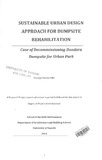| dc.description.abstract | Neglecting of 4R hierarchical solid waste management, reject, reduce, recover
and reuse has led to questionable urban environmental qualities contrary to
Nairobi the green city. Key to the study is investigating the rehabilitation
strategies through landfill mining (LFM) concept, vegetative cover concept and
their benefits to a sustainable urban environment. A literature review was done
on hazards of waste, LFM process and its benefits, use of plant cover to ‘cure’
recovered soil and their secondary benefits, sustainability concept and its
application in cities, cost-benefit model and best practices in LFM. Further the
study examined the physical, social, environmental, and economic attributes in
developing an urban design approach for dumpsite rehabilitation. However,
environmental aspect were found wanting and formed the basis of study‘s
approach. The research methods applied included interviews and observation.
The findings from Dandora dumpsite revealed the reviewed concepts on
sustainable approach for rehabilitating the landfills to improve the livelihood of
urban dwellers in creation of urban Public Park and increase the environmental
benefits. The study recommended use of LFM concept coupled with vegetative
cover to create a sustainable Dandora urban park.
Key words: landfill, solid waste, sustainability, landfill mining, landfill
rehabilitation, vegetative cover, evapotranspiration, phytoremediation | en_US |

